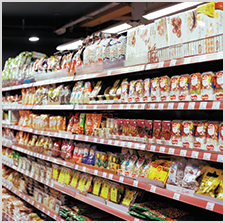What Does Your “New” Shopping Experience Look Like?
August 18, 2020
Let’s think back to earlier this year, we were in the midst of potential lockdowns or illness, and many consumers overbought products. Consumers didn’t pay attention to the labels, they prioritized the product itself – not the brand, not the number per package — they just needed the toilet paper, antibacterial wipes, sanitizer, water, or food! Now, let’s fast forward to the present day. A time, still filled with uncertainty, but a little more stability and progress in maneuvering through the “new normal” of life. A time when labels and packaging are still very relevant, but their role in consumer purchase decisions has changed.
Let’s talk about some of the trends and ways in which companies have had to pivot amongst the challenges that coronavirus has caused. How have labels and packaging in the food, beverage, and consumer product space changed in 2020?
Food
Our grocery shopping experience has dramatically changed in 2020. Shelf-stable foods are flying off the shelves as consumers seek to fill their pantries. Consumers are utilizing new online shopping platforms to do much of their grocery shopping, limiting their in-store exposure time for essential products only. Knowing that consumers aren’t entering stores in person as much as they used to, are there adjustments that need to be made to your label or packaging to be successful in the e-commerce platform? Even when consumers are entering stores, they are less likely to touch multiple products to learn more about an item, because they are trying to limit the spread of germs. Information presence on the packaging has always been imperative, but now more than ever consumers need the most relevant and important information on the front to ensure additional handling of a product isn’t required.
Beverage
Throughout 2020, the bar and restaurant industry has had to adjust significantly. There were times when bars and restaurants were completely closed, offering curbside pickup, or open with limited capacity – they’ve seen it all. This has had a major effect on the beverage industry with less on tap needs and brand owners adapting to push more convenient, on the go offerings in bottles and cans. These efforts have been successful but also come with challenges. Beverage companies are finding aluminum cans hard to come by. In an effort to combat the shortage and move forward, we are seeing brands are moving volume that was in pre-printed cans to glass bottles utilizing cut and stack or pressure sensitive labels instead.
Consumer Products
The food and beverage industries are not the only one’s pivoting. We’ve seen significant changes in the consumer products industry as well. Early on, many companies in the craft beer and distillery market started to produce hand sanitizer to help not only keep their machines running, but also provide a much-needed product. Hand sanitizer and disinfecting wipes are still flying off the shelves and near impossible to find months later.
Big brands are reviewing their product portfolios to minimize the number of SKUs they are producing and streamlining their flagship brands in an effort to get product out the door quicker. Consumers are seeking positive reinforcement when it comes to disinfecting products. We have learned that some products are more effective against coronavirus, so it has been essential for brands to promote their wipes and sanitizers as “confirmed effective against coronavirus.”
Sustainability has been a hot topic for many years, and it may be too early to tell at this point how coronavirus may affect sustainability initiatives. Will brand owners relook at sustainability initiatives with coronavirus concerns and potentially go back towards one-time use products to fight against the spread of germs? Only time will tell.
All in all, 2020 is a year of change and adaptability and your labels and packaging play a huge part. Consumers’ shopping experiences have changed, and their expectations of packaging are different than they once were. Does your brand’s packaging reflect the new priorities of the consumer?



